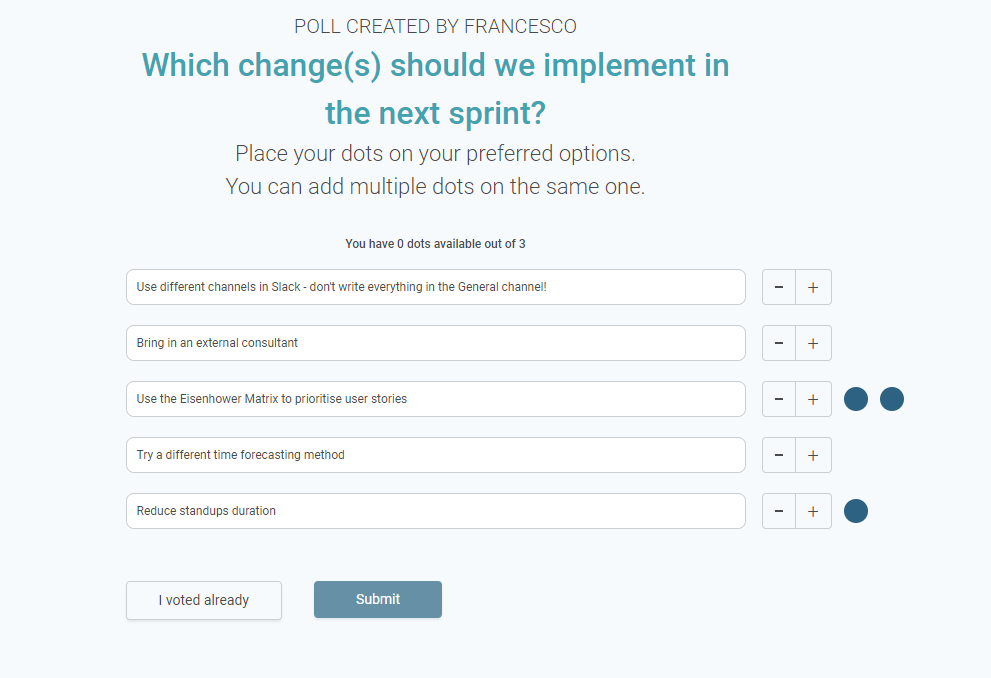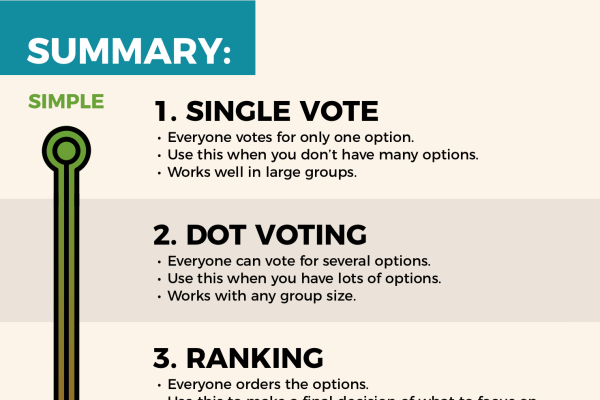
Dot voting: Because one vote is not enough
Francesco Marcatto26 Mar 20
Table of contents
I love dot voting. I mean, I really love dot voting. But there are also some things I don’t like so much about dot voting. If you do it right, it’s a fantastic and democratic tool for giving the right meaning to creativity, problem-solving, and prioritisation meetings. Do it wrong, and it becomes a collection of social and cognitive biases.
In this article, I’ll go through the pros and the cons of dot voting, and I’ll show you how to overcome its limitations with ease.
The good
Especially, I love the idea of being able to choose multiple options. It is made for people like me, who always have a hard time choosing one single thing among many attractive alternatives. I call this “the ice cream parlour dilemma”: chocolate looks yummy, but I also love stracciatella, and what about that amazing Bronte pistachio? Gosh, there’s no way I’ll be happy with my choice. For sure I’ll end up regretting not having chosen differently. Indeed, too many good options and one single choice is the perfect recipe for choice overload.
But giving peace of mind to the chronically undecided like me is just one nice side effect of dot voting. The big advantage of dot voting is that the perfect tool for all those situations where your team need to converge on a set of alternatives, and not just to elect a single winner.
For example, if your objective is to find a name for your new app, then the traditional “one head-one vote” poll is enough. In most problem-solving sessions, however, it is wiser to end with a number of different smart solutions, so you can attack the problem from various angles at the same time. Not to speak about prioritisation meetings: dot voting is clearly the king here.
Pro tip: Do you want to use the traditional single vote method using your favourite digital dot voting tool? Just set the numbers of dots to 1 and voilà!
The bad
There’s actually nothing wrong in dot voting, the villain lives elsewhere. The problem lies, well, in our own nature.
Evolution shaped our cognitive system so that we are spontaneously able to use a number of heuristic strategies, that are simple but clever cognitive shortcuts which make. Usually, these heuristics works fine, but in some situations they can lead us to sub-optimal (or just plain wrong!) behaviours. You probably have already heard about biases. This is the price we have to pay for moving quickly and (usually) effectively in an extremely complex environment, despite having some serious constraints in our cognitive systems (this is the bounded rationality theory of the Nobel prize Herbert Simon).
Unfortunately, classic dot voting, that is placing sticky dots on the whiteboard together with your team, is a bias-inducing situation.
One cognitive bias is the consequence of the well-known primacy effect. When presented with a list of alternatives, we tend to remember better and to prefer the first elements we’ve seen. As a consequence, the options at the beginning of the list could receive more dots just because of their position.
Another -stronger- bias lies in the social nature of this method. Classic dot voting is seen as a team exercise, so dots are usually placed publicly, there should be no secrets among us.
Right, but this leads to more biases. We are influenced by other people’s behaviour. And I mean everyone, even the most nonconformist among us. So when you see the boss (or someone else you respect) placing her dot on alternative #3, it’s hard not to be at least somewhat influenced (authority bias).
And even if you don’t see who voted for what, just seeing that an alternative is already covered with dots makes us think “hey, if my teammates voted for this, it should be a good one” (this bias goes by many names: social proof, bandwagon effect, or conformism bias).
Bias-free dot voting
Ok, it’s a great tool with some (serious) flaws. This doesn’t mean we have to throw out the baby with the bathwater!
There’s a simple solution: anonymous, private dot voting. Give each member a copy of the alternatives (if you can, randomise the list for each person, so to avoid the primacy effect), let each one put the dots wherever they want, and then collect them all and aggregate the votes.
If this sounds complicated, then here’s a simpler solution: use a digital tool which will do all the hard work for you.
In Decido, for example, the options are presented in a random order to every user (so long, primacy effect!), votes are totally anonymous and you’ll see other votes only after you’ve voted (authority bias and conformism bias? no, thanks!). All the pros of dot voting, without the cons.

Bottom line
I love dot voting and think that it is incredibly useful in many situations. Traditional whiteboard dot voting, however, can lead to less-than-optimal results due to some cognitive and social biases. Smart online tools, however, can easily overcome these flaws, so I totally suggest to go digital even when you’re running an in-person dot voting session. Let me know your experience with dot voting!







